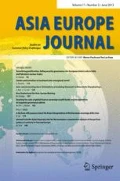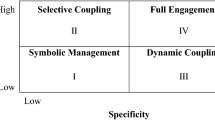Abstract
Trade interdependence between Europe and Asia has rapidly increased in recent years. Europe–Asia trade flows now constitute a ‘third link’ in the global economy. As trade expands, however, global trade governance has declined and free trade agreements (FTAs) have increased. Hence, the Global Europe strategy has been designed to enhance trade relations with emerging Asia which is the most dynamic region in the global economy today. But Asia’s model of export led growth leaves it more exposed to shocks emanating from outside the region than ever before raising questions about its sustainability. Deep integration agreements between Europe and Asia are needed to foster economic growth. They also need a development dimension to help Asian countries address their key development challenges.

Similar content being viewed by others
Notes
East Asia is usually defined as ASEAN + 3 comprising North and South East Asian countries, but India is increasingly linked to this grouping and is a member of the East Asian Summit.
Article XXIV of GATT and Article V of GATS stipulate that FTAs are acceptable if they lead to closer integration of economies, cover substantially all trade in goods, have substantial sector coverage for services and eliminate substantially all discrimination.
Lars Nilsson (2008), presentation to the workshop ‘The Policy Perspective: EU approach to FTAs’.
For a comprehensive analysis of the EU’s new trade agenda for the WTO see Gavin (2001).
Presentation by Karl Falkenberg, chief trade negotiator in the European Commission, in the European Parliament, 11 October (2007).
Presentation made by Joachim Ihrcke, President of the European Chamber of Commerce of Singapore, to the Multi-stakeholder Dialogue on the Current Negotiations of the ASEAN-EU Free trade agreement, Bangkok, 14 February, (2008).
The figures presented here come from the IMF Asia and Pacific Regional Economic Outlook, October 2007, summarised by Gruenwald and Hori (2008) in the IMF Survey magazine.
References
Birdsall N, Lawrence RZ (1999) Deep integration and trade agreements: good for developing countries. In: Kaul I et al (ed) Global public goods: International cooperation in the 21st century. Oxford University Press, New York
Brown AG, Stern RM (2006) Issues of fairness in international trade agreements. University of Michigan International Policy Centre
Cohen-Setton J, Pisani-Ferry J (2008) Asia–Europe: The Third Link’. Brueghel Working Paper, No. 4, October.
European Commission (2006a) Why is trade openness good for development? Brussels, European Commission, Directorate General Trade, 3 April: http://trade.ec.europa.eu/doclib/docs/2006/september/tradoc_129992.pdf.
European Commission (2006b) Global Europe: competing in the world. A Contribution to the EU’s Growth and Jobs Strategy’. European Commission, Brussels
European Commission (2007) Global Europe: A stronger partnership to deliver market access for European exporters. COM (2007), Brussels, 183 final
Falkenberg K (2007) Presentation on EU Strategy for FTAs to Meeting of EU and EFTA Parliamentarians in the European Parliament, Brussels, 11 October
Gavin B (2001) The European union and globalisation; towards global democratic governance. Edward Elgar, Cheltenham UK
Gavin B (2006) Regional trade agreements in East Asia: Implications for the multilateral trade system. paper presented at the conference Possibilities for an East Asian Community: Asian Regional Integration by Learning from Europe, Osake City University, Japan
Gavin B, Lee S (2007) Regional energy cooperation in North East Asia: Lessons from the European Experience. Asia Europe J 5:401–415
Gavin B (2008) The European model of deep integration: How relevant for East Asia? In Andreosso B, Zolin B (eds) Asia and Europe; Connections and contrasts, Ca’Foscari University of Venice Press
Gruenwald P, Hori M (2008) Intra-regional trade key to Asia’s export boom. IMF Survey Magazine; Countries & Regions
Ihrcke J (2008) The Business Community’s expecations from an EU-ASEAN FTA. Presentation made at Multi-stakeholder Dialogue on the Current negotiations of the ASEAN—EU Free Trade Agreement, hel in Bangkok, Thailand, 14th February
Kuroda H (2006) Towards deeper asian economic integration: Progress and prospects. Harvard University Business School, Cambridge MA
Maddison A (2001) The world economy: a millennial perspective. OECD, Paris
Nilsson L (2008) The Policy Perspective: EU Approaches to FTAs. Presentation at workshop on ‘Deep Integration and North–South Free Trade Agreements; EU Strategy for a Global Economy’
Rodríguez F, Rodrik D (2000) Trade policy and economic growth: a skeptic’s guide to the cross-national evidence. In: Bernanke B, Rogoff KS (eds) Macroeconomics annual 2000. MIT Press for NBER, Cambridge MA
Rodríguez F (2006) Openness and growth: what have we learned? New York, background note for the United Nations’ 2006 World Economic and Social Survey
Rodrik D (2002) Feasible globalizations, mimeo, Harvard University
Sindzingre A (2007) Explaining threshold effects of globalisation on poverty: an institutional perspective. In: Nissanke M, Thorbecke E (eds) The impact of globalization on the world’s poor: transmission mechanisms. Palgrave Macmillan, London
Sindzingre A (2008) ‘EU Economic Partnership Agreements with Sub-Saharan Africa’, UNU-CRIS Working Paper 2008/5, Bruges, Belgium
Srinivasan TN (1996) Post Uruguay round issues for Asian developing countries. Asian Development Rev 14(1):1–28
Stiglitz J (2006) Fair trade for all: how trade cann promote development. Brooks World Poverty Institute, University of Manchester, February, 2006
Wacziarg R (2001) Measuring the dynamic gains of trade. World Bank Econ Rev 15(3):393–429
Wacziarg R, Welch KH (2008) Trade liberalization and growth: new evidence. World Bank Econ Rev 22(2):187–231
Author information
Authors and Affiliations
Corresponding author
Additional information
Brigid Gavin was the Research Coordinator of the workshop on ‘Deep Integration and North–South Free Trade Agreements: EU Strategy for a Global Economy’ which provided the papers and discussion forum for the articles in this special edition. The workshop took place at the United Nations University-Comparative Regional Integration Studies (UNU-CRIS) centre in Bruges, Belgium on 19–20 June, 2008. She wishes to express her thanks to Mr Luk Van Langenhove, Director of UNU-CRIS for financial support and to all the authors and participants in the workshop for their contribution to making this project a real success. A special word of thanks goes to Lars Nilsson, Chief Economist Unit, DG Trade, European Commission for his opening presentation to the workshop.
Alice Sindzingre is Research Fellow, National Centre for Scientific Research (CNRS), University of Paris and Visiting Lecturer at School of Oriental and African Studies (SOAS), University of London. This analysis draws from her paper ‘The EU Economic Partnership Agreements with Africa’ which she presented at the workshop and available on the UNU-CRIS website.
Annex 1: Progress towards the millennium development goals in Asian countries
Annex 1: Progress towards the millennium development goals in Asian countries
India
According to the Indian Government, the number of people living below the poverty line has fallen from 37.5% in 1990—the baseline year for MDG, to 22% in 2005 which suggests that the goals of 2015 will be met. However the World Bank has recently recommended that the benchmark for extreme poverty should be raised to $1.5 a day, which would change the picture significantly in India. The revised benchmark would increase the amount of poverty to 42% of the population, that is over 450 million people. Whatever the figures, it is clear that large numbers of households in India still live close to the poverty line and there has been little improvement in malnutrition in India over the past 10 years.
Indonesia
Despite efforts by the Indonesian government to achieve the MDGs, the latest progress report disclosed that 16.6% of the total population lived below the poverty line in 2007—which is more than in 1990. Another rising indicator is the number of children under five years of age that are severely underweight. Thirty-five per cent of the population have incomes that place them only marginally above the poverty line which makes them very vulnerable to adverse economic changes.
Malaysia
It is one of the wealthiest and most developed countries of South East Asia, only surpassed by Singapore and oil-rich Brunei. Malaysia is being held up as a model for the Asia Pacific region as it has already achieved seven of the eight MDGs. Since 1970, the percentage of the population living below the poverty line has fallen from 50% to 5%, extreme poverty is rare, and infant mortality has dropped from 40.9% to 7.9% of 1,000 births and adult literacy has increased from 64% to 90%. However, the Gini coefficient is the highest in the region showing large inequality between urban and rural areas.
Thailand
Due to its strong economic performance, Thailand has made significant progress towards achieving most of the MDG targets. The percentage of the population living below the poverty line has dropped from 38% in 1990 to 11% in 2004, with literacy rates at 96% for men and 91% for women and almost universal primary education enrolment Because Thailand has already done so well, it has set itself the new targets of MDG + to further decrease poverty levels to 4% by 2009. However the environment has suffered due to the rapid economic progress.
The Philippines
It is called a middle income developing country but it suffers from major development problems. Recent adverse developments have raised doubts about the country’s ability to reach the MDG targets of 2015. Between 2003 and 2006 extreme poverty increased in the country from 13.5% to 14.6% while the broader measure of poverty assessed by inability to buy food and other essentials rose from 30% to 32.9%. The MDG targets are 12% and 22.5% for the two measures of poverty.
Cambodia
Cambodia has made slow progress towards achieving the poverty reduction goals of the MDGs. The latest World Bank Poverty Assessment shows that 35% of Cambodida’s population live below the national poverty line, and the overall reduction has been only 10% over the past decade. Nearly 80% of the population survive on less than $2 a day, while a small elite enjoys a business boom in the capital city. Cambodia has become one of the most unequal countries in Asia in terms of divergence between rural poverty and urban wealth.
Laos
Results towards achieving the MDGs are disappointing and the targets will be further challenged by the projection that the population will double in less than 25 years. In 2005, 27% of the population remain below the $1 a day benchmark of extreme poverty—which is a considerably higher figure than what was recorded in the 1990s. According to the Governments own evaluation, the amount of extreme poverty has fallen from 46% in 1992 to 38% in 2004—the latest figures available. This is insufficient progress to meet the target of 24%.
Vietnam
It has the most successful record among developing countries for reducing poverty to meet the MDG goals. It has achieved the goal of halving poverty one decade in advance of 2015. According to the most recent progress report, published in 2005, the number of families living below the poverty line (defined in terms of food and non-food essentials) fell from 58% in 1993 to less than 24% in 2004, while extreme poverty—defined in terms of food alone—fell from 25% to below 8%. It is believed that this positive trend has continued since then. Vietnam has also made remarkable progress in achieving other social targets of MDG—except those of HIV-AIDS and sanitation.
Rights and permissions
About this article
Cite this article
Gavin, B., Sindzingre, A. EU trade relations with Emerging Asia: identifying the issues. Asia Eur J 7, 9–22 (2009). https://doi.org/10.1007/s10308-008-0220-0
Published:
Issue Date:
DOI: https://doi.org/10.1007/s10308-008-0220-0




